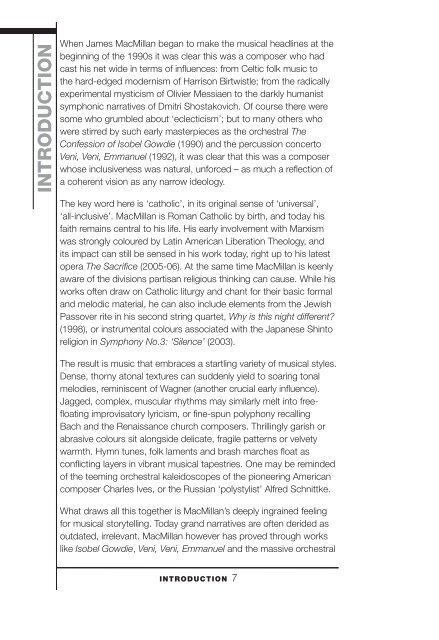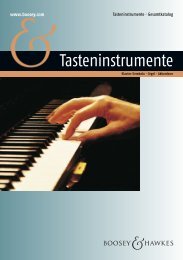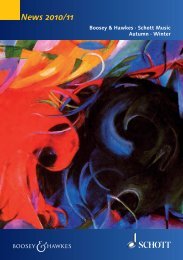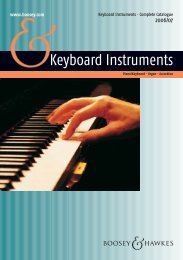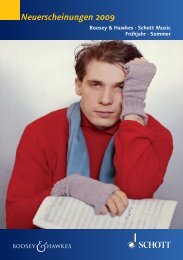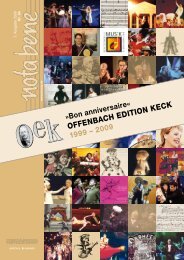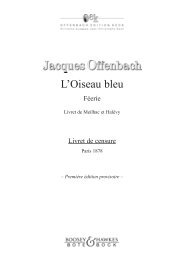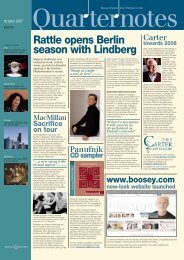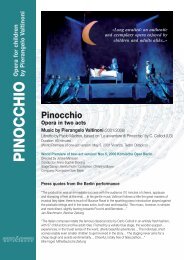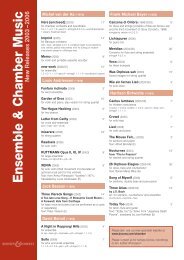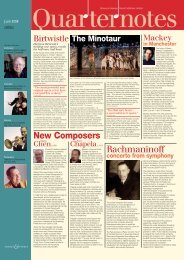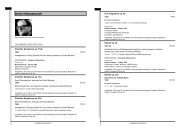Create successful ePaper yourself
Turn your PDF publications into a flip-book with our unique Google optimized e-Paper software.
INTRODUCTION<br />
When James MacMillan began to make the musical headlines at the<br />
beginning of the 1990s it was clear this was a composer who had<br />
cast his net wide in terms of influences: from Celtic folk music to<br />
the hard-edged modernism of Harrison Birtwistle; from the radically<br />
experimental mysticism of Olivier Messiaen to the darkly humanist<br />
symphonic narratives of Dmitri Shostakovich. Of course there were<br />
some who grumbled about ‘eclecticism’; but to many others who<br />
were stirred by such early masterpieces as the orchestral The<br />
Confession of Isobel Gowdie (1990) and the percussion concerto<br />
Veni, Veni, Emmanuel (1992), it was clear that this was a composer<br />
whose inclusiveness was natural, unforced – as much a reflection of<br />
a coherent vision as any narrow ideology.<br />
The key word here is ‘catholic’, in its original sense of ‘universal’,<br />
‘all-inclusive’. MacMillan is Roman Catholic by birth, and today his<br />
faith remains central to his life. His early involvement with Marxism<br />
was strongly coloured by Latin American Liberation Theology, and<br />
its impact can still be sensed in his work today, right up to his latest<br />
opera The Sacrifice (2005-06). At the same time MacMillan is keenly<br />
aware of the divisions partisan religious thinking can cause. While his<br />
works often draw on Catholic liturgy and chant for their basic formal<br />
and melodic material, he can also include elements from the Jewish<br />
Passover rite in his second string quartet, Why is this night different?<br />
(1998), or instrumental colours associated with the Japanese Shinto<br />
religion in Symphony No.3: ‘Silence’ (2003).<br />
The result is music that embraces a startling variety of musical styles.<br />
Dense, thorny atonal textures can suddenly yield to soaring tonal<br />
melodies, reminiscent of Wagner (another crucial early influence).<br />
Jagged, complex, muscular rhythms may similarly melt into freefloating<br />
improvisatory lyricism, or fine-spun polyphony recalling<br />
Bach and the Renaissance church composers. Thrillingly garish or<br />
abrasive colours sit alongside delicate, fragile patterns or velvety<br />
warmth. Hymn tunes, folk laments and brash marches float as<br />
conflicting layers in vibrant musical tapestries. One may be reminded<br />
of the teeming orchestral kaleidoscopes of the pioneering American<br />
composer Charles Ives, or the Russian ‘polystylist’ Alfred Schnittke.<br />
What draws all this together is MacMillan’s deeply ingrained feeling<br />
for musical storytelling. Today grand narratives are often derided as<br />
outdated, irrelevant. MacMillan however has proved through works<br />
like Isobel Gowdie, Veni, Veni, Emmanuel and the massive orchestral<br />
INTRODUCTION 7


